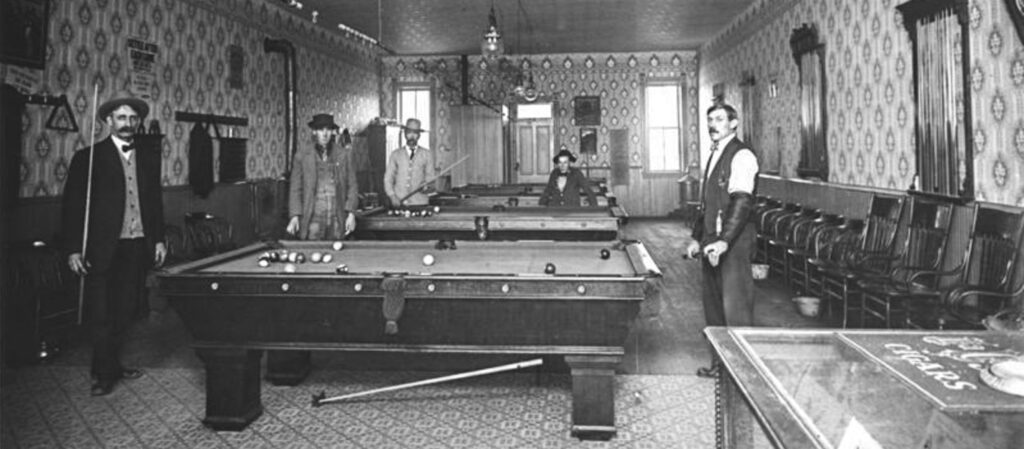SUMMARY
POOL - A Game on the Wire

Pool, a game once steeped in the traditions of American leisure and camaraderie, has struggled to maintain its place in the cultural and economic landscape of the United States. From the smoky rooms of early 20th-century pool halls to the professional circuit, the sport has encountered a series of challenges that have threatened its existence, leaving it often balancing precariously “on the wire” between popularity and obscurity.
In the early 1900s, pool halls were vibrant centers of social activity, attracting a diverse crowd that ranged from blue-collar workers to upper-class elites. These establishments became a staple in many American cities, often filled with the sound of clinking balls and the hum of casual conversation. At the height of the sport’s popularity in the mid-20th century, the United States was home to an estimated 350,000 pool halls, catering to a booming demand for recreation and leisure. However, the rise of other forms of entertainment in the 20th century — from movie theaters to television — led to a steady decline in the popularity of pool. The expansion of suburban life, paired with an increasing emphasis on family-friendly entertainment, created new challenges for pool halls, which were often seen as places of vice and undesirable behavior. By the 1970s, the number of pool halls began to dwindle, and by the 1990s, only about 100,000 remained.

Today, the number of traditional pool halls in the United States has dropped significantly. Estimates suggest that fewer than 5,000 pool halls exist today, a fraction of the number that once flourished. The decline in pool halls is a reflection of broader social changes, including the increasing popularity of other pastimes and the rising costs associated with running these establishments. The market for pool halls has been further constrained by the rapid growth of online gaming and the proliferation of entertainment options available to younger generations. With the advent of home entertainment systems, as well as the decline in the number of individuals playing recreational games in public venues, many pool halls have either closed or adapted to other functions, such as becoming bars, arcades, or multi-purpose entertainment spaces.
At the same time, professional pool players found themselves struggling to gain recognition and respect within the sports world. Unlike other athletic disciplines that offered large sponsorships and consistent media coverage, pool players faced a much more uncertain future. With limited financial opportunities, many professional players were forced to compete in regional tournaments or rely on gambling for income. The game was largely ignored by major sports networks, and the lack of a clear, mainstream fan base made it difficult for players to turn their passion into a sustainable career. While figures like Minnesota Fats and Willie Mosconi became legendary in the 1940s and 1950s, their fame was often more rooted in personal charisma and media portrayals than in the sport’s actual prominence.
As the decades have passed, pool has remained “on the wire,” surviving as both a niche sport and a pastime, but never quite reaching the heights of widespread recognition or financial security enjoyed by other more mainstream activities. The rise of online gaming, the increasing cost of running pool halls, and the slow decline in the number of young players entering the sport have made it harder for pool to thrive as a commercial enterprise. Moreover, the sport’s struggle to modernize — to capture the attention of a younger, tech-savvy generation — has proven difficult.
Today, professional pool players face an increasingly complex landscape. The internet has brought new opportunities for exposure, but it has also introduced fierce competition, as streaming platforms and video games vie for the same audience’s attention. With limited prize money at tournaments, sponsorships remain scarce, and many players still find it difficult to make a full-time living from their skill. Even as the sport garners a modest resurgence in some circles, the financial and media spotlight remains dim.
The game of pool in America has faced a long-standing battle to remain relevant in an ever-evolving cultural and economic environment. The decline of pool halls — from a high of 350,000 to fewer than 5,000 today — coupled with the struggle of professional players to survive financially, has left the game hanging in a fragile balance. Despite these challenges, the resilience of the sport and its dedicated players continues to offer hope that pool can still find a place in the hearts of future generations. However, it must overcome significant obstacles to do so, as it remains a game constantly teetering “on the wire” of cultural and economic survival.
